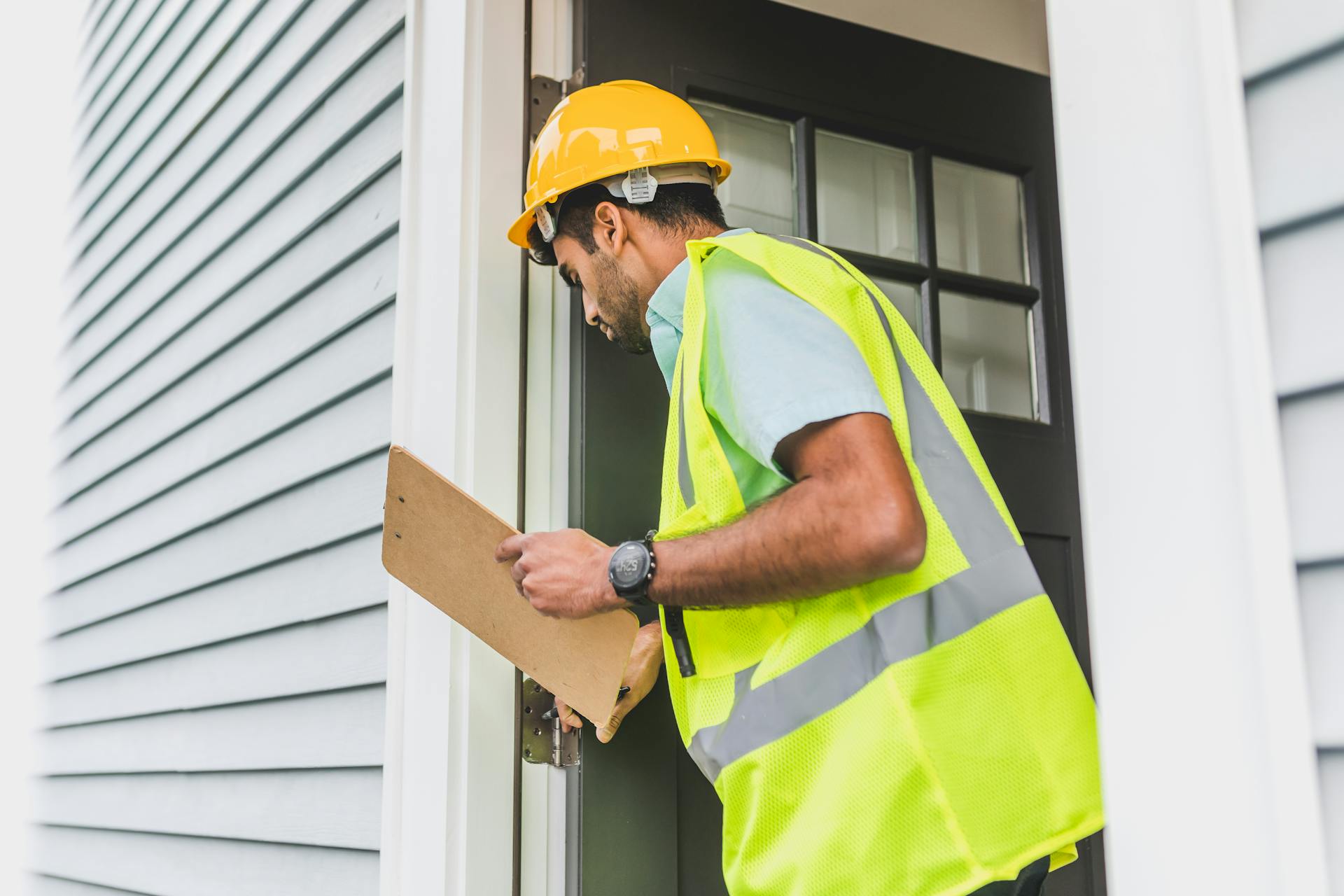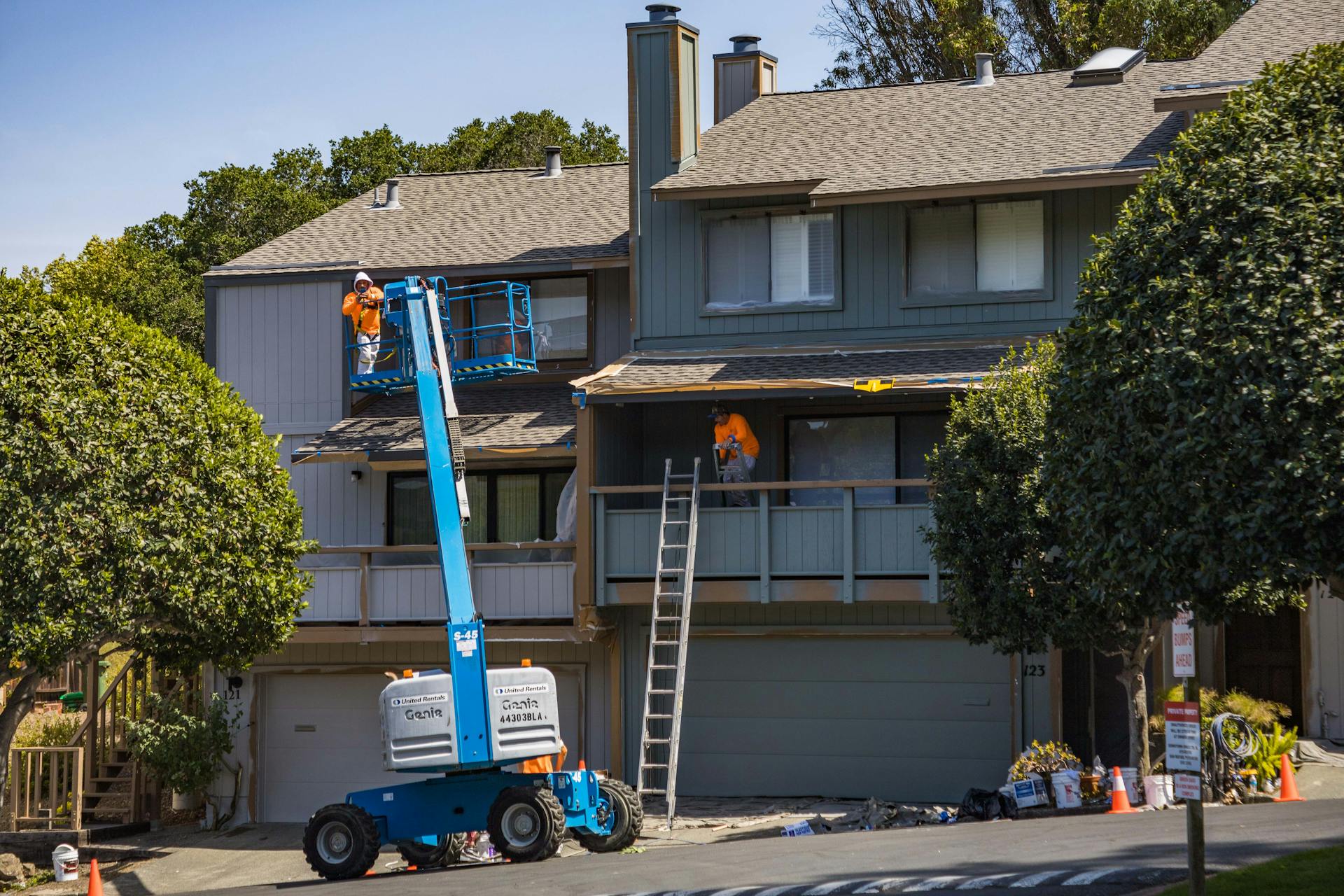
Leaks can be a major issue with hydraulic liftgates, and one of the most common causes is a faulty seal. This can be due to wear and tear over time, or damage from heavy use.
A hydraulic leak can cause the liftgate to malfunction, making it difficult to open or close. This can be frustrating and even pose a safety risk.
Regular maintenance is key to preventing leaks and other issues with hydraulic liftgates. This includes checking the fluid level and condition regularly, as well as inspecting the seals and hoses for signs of wear.
By staying on top of maintenance, you can help extend the life of your hydraulic liftgate and prevent costly repairs down the line.
Common Issues
If your hydraulic liftgate isn't operating, it's essential to check the power supply. Ensure the vehicle battery is charged and that the liftgate's power switch is turned on. Look for any blown fuses or tripped circuit breakers.
A slow-moving liftgate could be due to low hydraulic fluid levels or a weak battery. Check the hydraulic fluid reservoir and top it off if necessary. Ensure your battery is fully charged and in good condition.
If your liftgate is stuck in one position, it might be related to the hydraulic system or a mechanical blockage. Inspect the hydraulic cylinders for leaks or damage and ensure there are no obstructions in the liftgate's path.
Unusual noises during liftgate operation often indicate mechanical wear or a hydraulic issue. Inspect all moving parts for signs of wear and tear, and check the hydraulic fluid for contamination or low levels.
Here are some common issues to look out for:
- Liftgate Won't Operate at All
- Liftgate Moves Slowly
- Liftgate Stuck in One Position
- Liftgate Makes Unusual Noises
Troubleshooting Steps
To troubleshoot hydraulic liftgate issues, you need to carefully inspect the system for any problems. First, locate the leak by tracing the hydraulic lines from the pump to the cylinder to identify any damage or worn-out seals.
A faulty seal can cause a significant leak, so it's essential to replace any damaged components. Replace the defective hydraulic hoses, seals, or O-rings with parts that match your lift gate model.
Refilling the hydraulic fluid and testing the system can help resolve the issue. Top off the hydraulic fluid, purge any air from the system by running the lift gate through a few cycles, and check if the problem is resolved.
Here are the troubleshooting steps in a concise format:
- Locate the leak and identify any damage or worn-out seals.
- Replace faulty components with matching parts.
- Refill the hydraulic fluid and test the system.
Fluid Leaks and Issues
Fluid leaks are a common problem with hydraulic liftgates, and they can be sneaky. They can start as a slow drip and eventually cause total malfunction.
Visible leaks or puddles usually indicate one or more hydraulic fluid leaks. Even a slow drip over time can eventually cause total malfunction.
Hydraulic leaks are among the most frequent issues affecting lift gates. Hydraulic fluid powers the lift gate's lifting and lowering actions, so performance suffers when there's a leak.
Low fluid levels can lead to slower operations, and the liftgate may stop working in severe cases. If the fluid reservoir drops below optimal levels, it's a tell-tale sign of a leak.
To diagnose a hydraulic leak, inspect the hydraulic lines for visible drips, stains, or wet spots. Pay special attention to joints, fittings, and seals, as these areas are prone to wear and cracks.
Here are some common causes of hydraulic leaks:
- Internal Hydraulic Cylinder Leak: A leaking lift cylinder may require a cylinder seal kit to fix it or, more efficiently, a new cylinder.
- Faulty Check Valve in the Hydraulic System: If the check valve fails, it will not maintain hydraulic pressure, causing the rear liftgate to lower unintentionally.
- Cylinder Lock Valve Clogged or Failing: If the cylinder lock valve is clogged or failing, it will not hold pressure and the gate can drop unintentionally.
Lift Gate Functionality
If your liftgate isn't operating, check the power supply, ensuring the vehicle battery is charged and the liftgate's power switch is turned on. Look for any blown fuses or tripped circuit breakers.
A liftgate that moves slowly could be due to low hydraulic fluid levels or a weak battery. Check the hydraulic fluid reservoir and top it off if necessary, and ensure your battery is fully charged and in good condition.
Irregular function, such as a liftgate moving unevenly, can be caused by a combination of factors including fluid leaks, damaged wiring, and/or a failing pump. Total inoperability may require significant hydraulic liftgate troubleshooting and repairs.
Here are some common liftgate issues and their possible causes:
- Liftgate Won't Operate at All: Power supply issue, blown fuse, or tripped circuit breaker
- Liftgate Moves Slowly: Low hydraulic fluid levels or weak battery
- Liftgate Stuck in One Position: Hydraulic system issue or mechanical blockage
- Liftgate Makes Unusual Noises: Mechanical wear or hydraulic issue
- Liftgate Tilts or Lowers Unevenly: Misaligned parallel arms, uneven hydraulic pressure, or pump/motor failure
Gate Not Lowering
If the lift gate isn't lowering, there are a few things to check. First, make sure the fuse at the pump and motor is good. It's located inside the main tube on the passenger side behind the rubber cover.
Start the truck and run the engine in a fast idle to charge the battery, as this can sometimes resolve the issue. If not, then you need to check the switch and grey 3 wire harness to switch for damaged spots.
To do this, see if there's a light or if you can read voltage in the cable. If you see a light or can read voltage, then the cable is okay. But if you see no light or 0 V, then the wire is damaged.
If the coil is bad, you'll know because the screwdriver won't get magnetically pulled towards the valve stem when you hit the down function. In this case, you'll need to replace the coil.
However, if the coil is good, then you'll need to check the S5 shift valve at the pump. This involves removing the coil on S5, removing the valve stem, and checking for debris on the stem. Clean the stem with brake clean and shop air, then slide the coil over the stem of the valve.
Disconnect the outer solenoid wire so the motor won't engage while the valve stem is removed, and then check that you can see the valve working while removed. If the valve is not responding, you'll need to replace the S5 valve.
Tilts or Lowers
If your liftgate tilts or lowers unevenly, there could be a combination of factors at play. A liftgate that tilts or lowers unevenly is often a sign of a deeper issue, so it's essential to get to the bottom of the problem.
The parallel arm system used in some liftgates, such as the GPT series, requires precise alignment for even movement. If the parallel arms are misaligned or damaged, the liftgate may not function properly.
Inspect the parallel arms for bends or damage, and adjust or replace them if necessary. This can often resolve the issue and get your liftgate back to normal.
Uneven hydraulic pressure or blocked lines can also cause one side of the platform to drop faster than the other. Check for fluid restrictions in one of the hydraulic lines, which may be causing the problem.
A worn-out pump or weak motor can lead to slow lifting and reduced capacity, resulting in uneven movement. This is often a sign that the pump or motor needs to be replaced.
Here are some potential causes of uneven liftgate movement:
- Misaligned Parallel Arms
- Uneven Hydraulic Pressure or Blocked Lines
- Pump or Motor Failure
Maintenance and Inspection
Regular maintenance is key to keeping your hydraulic liftgate in good working condition. It's essential to follow a regular maintenance checklist for each liftgate, as recommended by Texas Hydraulic & Equipment.
Thoroughly training staff in proper liftgate use is also crucial, as it can help prevent accidents and damage to the equipment. Conduct daily liftgate inspections, including signs of excessive wear or leaks, to catch any potential issues early on.
A resettable circuit breaker inspection should be performed to check if the breaker has been triggered. If so, reset it by following the manufacturer's instructions. If the breaker is still malfunctioning, consider replacing it with one of the same amperage.
Here are some common signs that you may need liftgate maintenance:
- Liftgate malfunctions
- Excessive wear or leaks
- Fuses on the power wire of the switch
It's also essential to inspect liftgate solenoids for signs of burnout and check all terminals to maintain tight connections and zero corrosion.
Signs for Maintenance Needed
Small issues with your liftgate can quickly become much worse over time if left unchecked.
Liftgate malfunctions often start as nearly imperceptible problems that gradually worsen.
If your liftgate is experiencing suboptimal operation, it's essential to address the issue promptly to prevent more significant damage.
Nearly all liftgate malfunctions will start as small issues that become much worse over time if neglected.
Regular maintenance can help prevent costly repairs and ensure your liftgate operates smoothly and efficiently.
The more your business depends on mobile liftgates, the more you should take liftgate preventative maintenance seriously to protect daily revenue streams.
Truck Maintenance Tips
Regular maintenance is crucial to keeping your trucks running smoothly. It's essential to keep a regular maintenance checklist for each liftgate to ensure ongoing equipment reliability.
Thoroughly training staff in proper liftgate use is also vital. This includes conducting daily liftgate inspections, including signs of excessive wear or leaks.
Collecting reports on leaks and other signs of disrepair is also important. You should also be on the lookout for signs of burnout in liftgate solenoids, often a result of low-voltage operation.
To maintain tight connections and zero corrosion, check all terminals regularly. Don't forget to inspect liftgate solenoids for signs of burnout.
Here are some key maintenance tips to keep in mind:
- Keep a regular maintenance checklist for each liftgate
- Thoroughly train staff in proper liftgate use
- Collect reports on leaks and other signs of disrepair
- Conduct daily liftgate inspections, including signs of excessive wear or leaks
- Check all terminals to maintain tight connections and zero corrosion
- Replace any degraded wire insulation or exposed wires
Fully charging liftgate batteries whenever possible and periodically load-testing them is also a good idea. This will help prevent liftgate failure and the resulting delays to your operations.
Leaks and Malfunctions
Visible leaks or puddles usually indicate a hydraulic fluid leak, which can cause total malfunction over time.
Don't ignore slow drips, as they can eventually lead to a liftgate that stops working altogether.
A hydraulic leak can cause performance issues, leading to slower operations and potentially causing the liftgate to stop working in severe cases.
Here are some common signs of a hydraulic leak:
- Visible drips, stains, or wet spots along hydraulic lines, especially around joints, fittings, and seals.
- Low fluid levels in the reservoir.
- Air bubbles in the fluid, causing the lift gate to jerk or move inconsistently.
A liftgate platform that slowly tilts down is not normal and often indicates a hydraulic system leak.
Fluid Leaks
Fluid Leaks are a common issue that can cause big problems for your liftgate. Don't ignore visible leaks or puddles, which usually indicate one or more hydraulic fluid leaks.
Even a slow drip over time can eventually cause total malfunction. It's like a slow leak in a tire, you might not notice it at first, but it can cause big problems down the road.
Hydraulic leaks are among the most frequent issues affecting lift gates. They can cause performance to suffer, leading to slower operations and even complete failure.
For your interest: Big Joe Electric Pallet Jack
If you notice a drop in fluid levels in the reservoir, it's a tell-tale sign of a leak. This is a clear indication that you need to investigate further.
To diagnose a hydraulic leak, inspect the hydraulic lines for visible drips, stains, or wet spots. Pay special attention to joints, fittings, and seals, as these areas are prone to wear and cracks.
A slow downward drift of the liftgate platform is not normal and can be a sign of a hydraulic system leak. This is a clear indication that you need to investigate further.
Here are some common signs of a hydraulic leak:
- Visible leaks or puddles
- Low fluid levels in the reservoir
- Air bubbles in the fluid
- Slow downward drift of the liftgate platform
If you notice any of these signs, it's essential to investigate further and address the issue promptly to prevent further damage.
Slow Raises (All GPT Models)
If your GPT series liftgate raises sluggishly, it's likely due to a hydraulic fluid issue. Low hydraulic fluid levels can cause this problem, so make sure to check the reservoir and refill it if necessary.

A common issue is hydraulic fluid thickening in cold weather, which slows down operation. Let the system warm up before use to prevent this.
Worn pump motor brushes can also cause slow raises. The 12V DC motor on the GPT liftgate's motor assembly uses brushes that can wear out over time, so replace them if performance declines.
Here are some steps to troubleshoot slow raises:
- Check the hydraulic reservoir and refill it if necessary.
- Let the system warm up before use in cold weather.
- Inspect and replace worn pump motor brushes.
Product Specific Issues
If you're experiencing issues with your hydraulic liftgate, it's essential to perform some initial checks before diving into troubleshooting. Always use a digital voltmeter to check the battery voltage, ensuring it's above 12.5 Volts.
Before proceeding, verify that all batteries have been load tested and connections are cleaned and connected correctly. This will help you identify any potential issues with the power source.
If you're getting a low reading on the 10-10 test, it's likely that the batteries are low, and you'll need to charge them. If the issue persists, it may be time to replace the batteries.
Consider reading: Low Profile Narrow Pallet Jack
To diagnose the problem, follow these steps:
- Check the cab switch to ensure it's ON.
- Verify that the resettable circuit breaker on top of the batteries is functioning correctly.
If the breaker has popped out, push the reset tab back in and retest. If the issue persists, proceed to the next step.
* Check for a solid ground connection from the motor post to the main frame of the liftgate.
If the connection is loose or corroded, tighten or replace it as needed.
If the liftgate is not lowering down, check both release valve wires for damaged spots. If you find any damage, repair or replace the wires accordingly.
Here's a summary of the steps to diagnose a stuck liftgate:
Remember to always follow proper safety protocols when working with hydraulic systems, and consult the manufacturer's instructions for specific guidance.
Frequently Asked Questions
Why is my liftgate going down slow?
A slow-moving liftgate platform is often a sign of a hydraulic system leak, which can cause it to tilt down instead of holding its position. Check for leaks to ensure safe and proper liftgate operation.
Sources
- https://liftgateme.com/blogs/liftgate-talk/lift-gate-not-working
- https://www.texhyd.com/blog/liftgate-issues-maintenance-tips
- https://liftgateme.com/blogs/liftgate-talk/maxon-lift-gate-gpt-troubleshooting-guide
- https://www.palfinger.com/microsite/nam/support/liftgates/en/ptf
- https://www.kingfleet.com/articles/common-lift-gate-issues-and-how-to-troubleshoot-them
Featured Images: pexels.com


